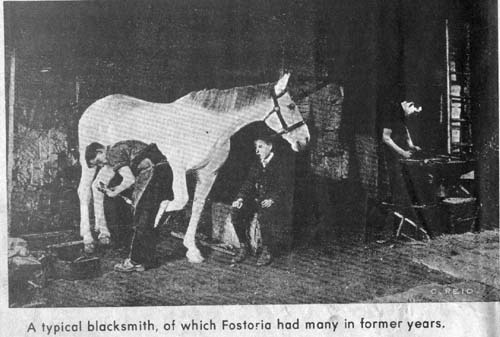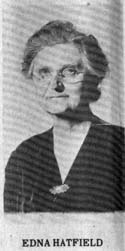March 16, 1977


Picture: A typical blacksmith, of which Fostoria had many in former years
I never see a school bus go by without thinking that when I was a youngster, my younger sister and I walked 10 blocks to school every day, winter and summer. No one took us in a bus, or the family car in bad weather. There were not many cars as yet, then. We trudged through rain, sleet and snow. Of course, in real bad weather we carried out lunch. All kids were in the same fix – the only difference was how close, or far, you lived from school.
Almost forgot to say that the school was Whittier – commonly called “Crocker Street” – where the new fire station is now. Whittier was opened for use in 1901.
On the way to school we’d often stop at Wonderly’s grocery, at the corner of South and Main, and buy two slices of bologna for our bread, and maybe a couple cookies. Peanut butter and jelly sandwiches hadn’t been invented yet.
I still remember some of the teachers at old Whittier. Miss Mason, Miss Fern McLaughlin, Miss Hershberger, Miss Francis McCormick, Mr. Poling, Mrs. Hatfield, Miss Woodruff, and one or two others but I can’t recall their names. Miss Woodruff married Asa Mann, both deceased. Mrs. Hatfield still lives on South Main Street. Mr. Hill, the janitor who would let us kids take turns ringing the bell, is deceased too.
Some of the kids that went there I still remember: Helene Wade, Francis Billyard, Alfred Fox, Kenneth “Fat” Keiffer, Harold Wilson, Gladys Doll, Carl Otten, Jan Emerine, Helen Fruth, Walter Fruth, Norman Fruth, Edna Youngblood, Mabel Wold, Ida Smith, Albert Smith, Delmar Holopeter, Thalia Rice, Aletha Rice, Cecil Hall, Dan Claypool, Earl Knotts, Bus Swartz, George Green, Leo Green, Roy Cousins, Carl Knestrick, Fred Shallenberger, Dorothy Shallenberger, Henry Geary, Claude Devore, Floyd Devore, Henry and John Adams, and others, but I can’t recall their names.
Mrs. Hatfield, taught at Whittier school for 41 years, of which 33 of those years she was also principal. She also taught three years at Columbus Ave., prior to moving to Whittier. She formally retired in 1950, but substituted for awhile.
Now, at 97, she is enjoying a well-earned retirement, with happy memories of teaching and students, many of whom still visit her.
On the way to school we would pass Miniger’s Livery Stable on west South Street, located where Mr. B’s Laundry is now. And then on just a little farther was Shoemaker’s Blacksmith Shop where we’d stop to watch them shoe horses. The owner was the father of Royal Shoemaker, who resides at 915 Leonard Street.
They would heat the shoes in their forge and while still red hot, fashion them to fit the horses hoofs. I still remember the clang – clang of their hammers on the shoes and the anvil, and it reminds me of Henry Wadsworth Longfellow’s poem:
Under the spreading chestnut tree
The village smithy stands.
The smith a might man is he
With large and sinewy hands.
At the end of the school day in the winter, I always had some chores, but mainly to get the coal buckets filled, and some kindling wood for the kitchen range, in case the fire went out.
My homework was done on the kitchen table and sometimes by a coal oil (kerosene) lamp because even in those days the gas pressure often was low in winter, so the lamp was out standby.
Oh yes, I almost forgot to say that during World War I all of us school kids – both boys and girls – learned to knit, in support of the war effort. At home and school we knitted scarfs and blocks to be put together for covers. That was out contribution to put down the Huns.
Oh, but that outdoor toilet was cold in winter. Later, when indoor plumbing and bath tubs became more common we had one too, but for many years the bath was taken in the wooden wash tub.
We got through that period without any serious scars. I’m not advocating a return to that period, with its many inconveniences, even though there are a lot of good things that can be said about it. But, I’m sure today’s generation have little or no knowledge of the hardships that their ancestors experienced in the march of progress to bring them the good things of today.